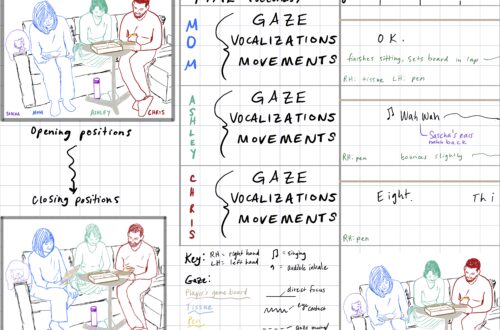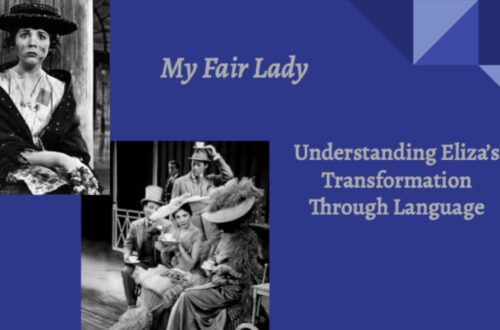“It’s pretty hard”: Stance and Dialogicality
Georgetown University, 2020. Linguistics.
[Sharing below a short paper from Discourse Analysis: Conversation, applying Du Bois (2007) to my data. My conversation data recording and transcripts are available here.]

According to Du Bois’ (2007) definition, “it’s pretty hard” is an expression of stance, and arriving at its meaning and interactional significance can only be achieved through identification of the participants involved, the object discussed, and the utterances that led to this remark.
Du Bois writes, “[i]n taking a stance, the stancetaker (1) evaluates an object, (2) positions a subject (usually the self), and (3) aligns with other subjects” (163). This predicates that stance acts include more than one subject (participant), and these subjects take stances relative to a shared object and each other. While some speculation regarding the sense of a stance utterance like “it’s pretty hard” can be made independent of other information, vital meaningis lost without identification of the current speaker, the intended recipient(s), the object (“it”) that is being evaluated as “pretty hard,” and consideration of its “dialogic” context (Bakhtin [1934]1981). Du Bois outlines two aspects of dialogicality: stance can only be fully understood contextually, including through referencing prior utterances; correspondingly, each new stance responds to a previous stance(s). In this paper, I will use examples from a dyadic interchange to demonstrate the way two speakers use evaluation, positioning, and alignment in taking stances and illustrate that these stances can only be thoroughly understood in light of their dialogic context.
The forthcoming examples are taken from a conversation between my fiancé, Chris, and myself shortly after relocating from New York City to Washington, D.C. Our snack of tea and biscotti prompted our discussion: appraising two kinds of biscotti – the first, from Trader Joe’s (hereafter TJ), the second, from our former neighborhood farmer’s market (hereafter NYC). These two kinds of biscotti serve as the principal shared objects around which Chris and I take stances.[1] Crucial to note is the exclusive use of deictics (“it,” “they,” etc.) to refer to these stance objects (in the full transcript,[2] “biscotti” are finally named in line 103). In none of the examples cited are the words alone sufficient for explicit understanding; without considering dialogic elements, including multimodal context, one would be unable to determine what the stance object is. Additionally significant is the way successive stances build from and must be understood through previous ones.
Preceding Chris’ initial comment in the following excerpt, I have taken my first bite of TJ biscotti; Chris has already been eating his piece, which he dips in tea to soften. Primarily through paralinguistic cues (e.g., intonation), he demonstrates a stance of surprise regarding my action. My agreement overlaps with his description of the TJ biscotti’s consistency:

Stances in this extract can be identified as: affective ‘surprise’ (line 2), aligning ‘agreement’ (line 3), and descriptive ‘consistency’ (lines 4-5). Regarding the first, from Chris’ intonation, one could infer a more complete affective statement like, “I’m surprised that you didn’t dip it in any tea.” Thus, one interpretation of his stance could be that he evaluates my lack of dipping “it” as unexpected, positioning himself as ‘surprised.’ In my compact answer (“yeah”), I respond to Chris’ stance by evaluating his statement (my stance object) as accurate, positioning myself as accepting it, and aligning in agreement with what he has said, though not necessarily with his position of surprise. Chris’ next turn builds on his previous stance by providing reasoning for his surprise: he descriptively evaluates the TJ biscotti as “pretty hard,” increasing to “hard.” This implies that Chris positions himself as perhaps not enjoying the TJ biscotti without dipping them in tea, aligning our positions as somewhat divergent (e.g., my actions could be seen as positioning me as not desiring dipping). Such an explanation of these stances not only illustrates the interaction of evaluation, positioning, and alignment, it further shows that, without contextual information and dialogical stance sequencing, certain meanings would be lost (e.g., the appropriate sense of “hard,” our positions regarding dipping in tea, and the identity of Chris’ referential object).
In the next example, Chris contrasts the “hard” TJ biscotti with the NYC biscotti, again describing consistency. I agree, then assert my own, affective stance toward the NYC biscotti. My remarks are overlapped by the continuation of Chris’ descriptive positioning:

In lines 6-7 and 9, Chris evaluates the NYC biscotti descriptively as being “softer,” indicating a comparison of at least two objects, and not requiring “dunk[ing]” (inviting the question, ‘dunking into what?’). His evaluations could suggest a position of preference (e.g., perhaps he thinks those attributes make the NYC biscotti better). Determining both the objects evaluated and positioning relating to this stance hinges on dialogicality. That one object is “the ones…from NY” is known from the text, but that these are biscotti (as are the items to which they are compared) is known only from prior context. Chris’ positioning of himself as enjoying the NYC biscotti independent of dunking (and possibly preferring them) is even more dialogically dependent, as Chris’ reference to dunking only makes sense in light of his earlier comment about my not dipping “it” in tea (line 2), his positioning of surprise at that, and his evaluation of the TJ biscotti being hard (possibly too hard to be enjoyed without dipping in tea). My stances in line 8 are likewise dependent on dialogicality, as well as paralinguistic cues. Since “I know those were really good” was delivered in one “intonation unit” (Chafe 1994) and transcribed without grammatical punctuation, it is only through pitch and emphatic stress that “I know” can be understood as a stand-alone statement; and then, in context of Chris’ previous stance, that mine is an alignment stance of agreement (the NYC biscotti are softer), rather than a primarily epistemic stance. Consequently, “those were really good” emerges as an affective stance, evaluating the NYC biscotti in a way that positions me as ‘really liking’ them.
In the excerpt below, Chris continues his comparison of the two biscotti, this time stating that TJ’s need dunking. I then signal my acceptance of his assertion:

Chris’s stance utterance in line 10 makes explicit his previously implied position (lines 2, 4-5) that his enjoyment of TJ’s biscotti almost depends upon their being dipped in tea. Along with the stance object being dependent on context, the need for “dunking” (lines 9-10) can only be understood as a need for ‘softening by submerging in tea’ based on prior stances. Through the minimal nature of my response (“yeah”) and my initial lack of dunking, one can infer my positioning as having a lower level of conviction about Chris’ claim and that my alignment is, therefore, less than completely “convergent” (162) with his. Without the context of the preceding stances, this might be read as my having the same positioning as Chris and a wholly convergent alignment.
As the above examples illustrate, stancetaking involves evaluation, positioning, and alignment of/by subjects and objects, and thorough understanding may only be approached when each aspect is considered in light of dialogic context. Contextual information can identify subjects, objects, and prior stances, which is vital to meaning making. Through this lens, one can locate the opening stance example of “it’s pretty hard” within this conversation to arrive at a reasonable interpretation – a stance that features a descriptive evaluation of TJ biscotti (the object) by Chris (the stancetaker), a position that he may find them too hard to enjoy without dipping them in tea, and an alignment somewhat divergent from the positioning taken by me (the other subject) in my preceding stance.
References
Bakhtin, M. [1934]1981. The Dialogic Imagination: Four Essays by M.M. Bakhtin. Austin, TX: University of Texas Press.
Chafe, W. (1994). Discourse, Consciousness, and Time: The Flow of Conscious Experience in Speaking and Writing. Chicago: The University of Chicago Press.
Du Bois, J. W. (2007). The stance triangle. In Robert Englebretson, ed., Stancetaking in Discourse: Subjectivity, Evaluation, Interaction. Amsterdam and Philadelphia: John Benjamins, pp. 139–82.
[1] Transcribed words relating to evaluation, positioning, and alignment are highlighted in green; objects, in blue.
[2] I have numbered my conversation excerpt lines according to where they appear in the complete transcript (attached) for easy reference (e.g., the first line that appears in this paper is line 2. Rather than renumbering it as “line 1,” I have continued to label it “line 2”). Additionally, my transcription conventions are indicated on the complete transcript.



